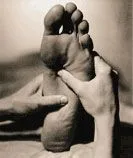Take this information with you by downloading a copy of our Laser Therapy brochure.
What is Laser Therapy?
Laser therapy or “photobiomodulation” is the use of specific wavelength of light (red and near-infrared) to create therapeutic effects. The effects include but not limited to improved healing time, pain reduction, increased circulation, decreased swelling and vasodilation. Laser therapy has been widely utilized in Europe by physical therapists, nurses, and doctors as far back as the 1970s. Now, after FDA clearance in 2002, laser therapy is being used extensively in the United States.
Has effectiveness been demonstrated scientifically?
Yes. There are literally thousands of published studies demonstrating the clinical effectiveness of laser therapy. Among these, there are more than 100 rigorously controlled, scientific studies that document the effectiveness of laser for numerous clinical conditions.
Cellular Effects of Laser Therapy
During laser therapy, the infrared laser light interacts with the tissues at the cellular level, and metabolic activity increases within the cell, vastly improving the transport of nutrients across the cell membrane. This initiates the release of nitric oxcide that leads to a cascade of beneficial effects, increasing cellular function and health.
Laser Therapeutic Effects
During each painless treatment, laser energy increases circulation, drawing water, oxygen and nutrients to the damaged area. These create an optimal healing environment that reduces inflammation, swelling, muscle spasms, stiffness, and pain. As the injured area returns to normal(homeostasis), function is restored and pain is relieved.
K-Laser Advanced Technology
K-Laser is leading the way in pain management, tissue repair, safe effective treatments, and fast treatment times. We are the premier laser company in the United States to offer:
- Dual-wavelength beam 800 nanometers and 970 nanometers, which penetrates deep into tissues.
- Continuous and modulating frequencies to promote pain control and healing.
- High-powered delivering larger doses, resulting in faster treatment times.
Dual Wavelengths and Dual Frequencies
The K-Laser was the first to employ dual infrared wavelengths simultaneously of 800 nanometers and 970 nanometers. These dual wavelengths are more efficient, healing tissue while also remarkably aiding in pain relief. Combining the K-Laser’s dual frequencies of continuous wave and modulation assures that each treatment you receive will be from the most advanced class IV 12-watt laser technology.
Patient Benefits of Laser Therapy:
Laser therapy is proven to biostimulate tissue repair and growth. The laser accelerates wound healing and decreases inflammation, pain and scar tissue formation as well as producing singlet oxygen, which destroys fungus. When it comes to pain management and fungus destruction class IV laser therapy provides dramatic results, is non-addictive and virtually free of side effects.
Numerous studies show that laser therapy can help with:
It’s a great physical therapy treatment for Tendonitis, Neuroma, Nerve Pain, Joint Pain, DJD/RA of any joint, especially the ankle, Achilles tendonitis, Plantar Fasciitis, and any type of inflammatory disease, condition.
Frequently Asked Questions:
Does it hurt and what does the treatment feel like?
There is little or no sensation during treatment. Occasionally, one feels mild soothing warmth or tingling. Areas of pain or inflammation may be sensitive briefly before pain reduction.
Are there any side effects or associated risks?
During more than 20 years of use by healthcare providers all over the world, very few side effects have even been reported. Occasionally, some old injuries or pain syndromes may feel aggravated for a few days, as the healing response is more active after treatment.
How long does each treatment take?
The typical treatment is 3-9 minutes depending on the pain and area being treated.
Can it be used in conjunction with other forms of treatment?
Yes! Laser therapy is often used with other forms of treatment including physical therapy, chiropractic adjustments, massage, soft tissue mobilization, electrotherapy, and even following surgery. Other healing modalities are complementary and can be used with laser to increase the effectiveness of treatment.
How often should the patient be treated?
Acute conditions may be treated daily, particularly if they are accompanied by significant pain. More chronic problems respond better when treatments are received 2-3 times a week, tapering to once a week or once every other week, with improvement.

